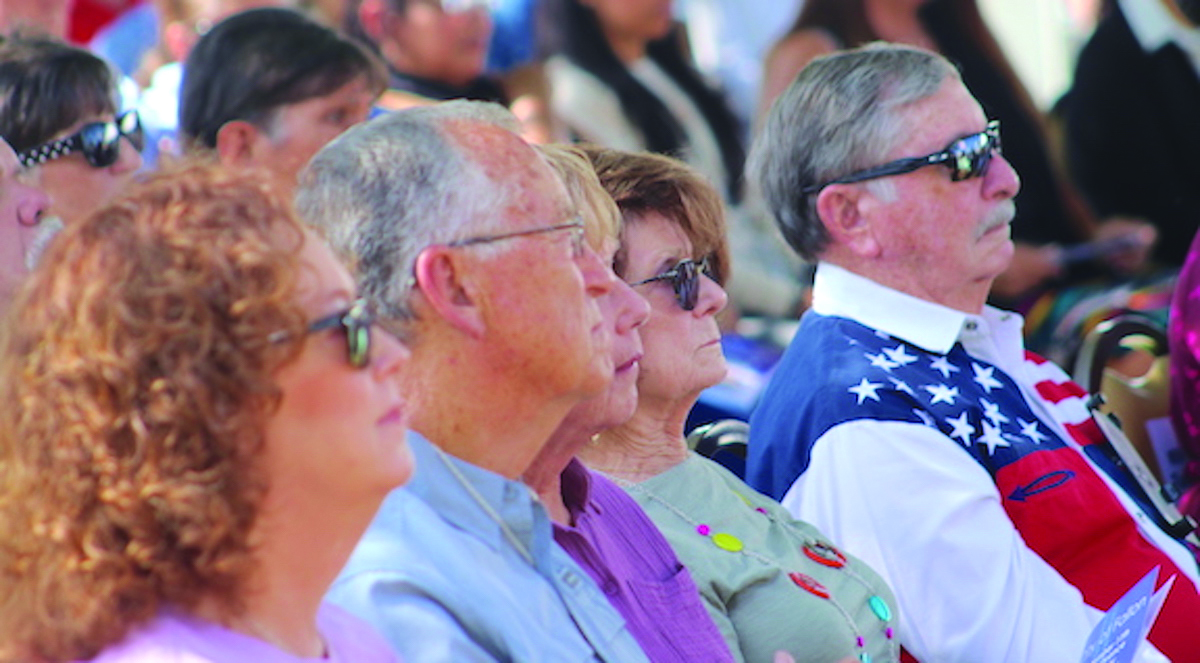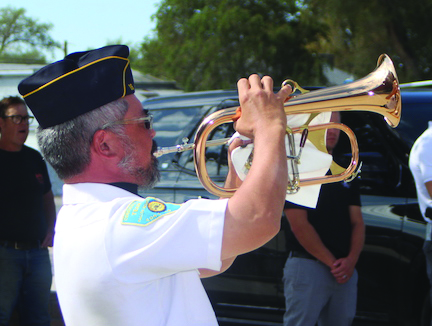Capt. Shane Tanner, commanding officer at Naval Air Station Fallon, reflects on his service after Sept. 11, 2001.
Twenty-two years ago, Sept. 11 began as a normal one for Capt. Shane Tanner, the current commander of Naval Air Station Fallon who spoke at this year’s Fallon 9/11 remembrance ceremony.
Tanner, speaking in front of one of the engines from the Fallon Churchill Volunteer Fire Department and a huge American flag, recounted how the day affected him like so many others in the military and local and state first responders.
As a young lieutenant (junior grade), Tanner was asleep in his bunk aboard the aircraft carrier USS John F. Kennedy until a jangly bell startled the Navy officer, causing him to jump to the floor. He answered the phone, and his buddy Jeremy “Hedgehog” Jameson was in the squadron ready room.
“Dude, you need to get down here,” Jameson urged Tanner, who was serving in his first organizational squadron, the “Bluetails” of Airborne Command & Control Squadron (VAW) 121 in Carrier Air Wing (CVW) 7.
On that Tuesday morning in 2001, terrorists hijacked four passenger jets that and by the end of that day, thousands of people died when two hijacked jets crashed into New York City's World Trade Center. Another jet slammed into one side of Pentagon and a fourth jet nosedived in a western Pennsylvania field.
Tanner, who was born in Auburn, New York and attended Texas A&M University, had been in the squadron for half a year and had completed several training detachments to the former Naval Strike and Air Warfare Center (NSAWC). He and other naval aviators were preparing to begin their carrier qualifications on Sept. 11, 2001, at the Roosevelt Roads Training Range in Puerto Rico. After Jameson’s call, Tanner hurried to the ready room and saw the others glued to the television, their mouths open, stunned.
“New plan,” Tanner emphasized. “The JFK spun around and began heading back north. Simultaneously, our sister ship, the USS George Washington, also in Norfolk, made ready on a moment’s notice and headed out to sea,” Tanner recalled.

Steve Ranson / LVN
From left, Heidi, Gary and Susan Imelli, along with Nancy and Ted Balash, listen to Capt. Shane Tanner’s remarks at Fallon’s 9/11 remembrance.
Half the air wing would fly from the Kennedy, the other half from the Washington. The two ships began to maneuver closer to the East Coast, thus allowing pilots to fly air defense missions. Tanner said the mindset indicated no one was going to penetrate the air space in what Tanner said was day one of Operation Noble Eagle.
“I was airborne on Sept. 12, and you could feel the silence that had draped over the world and our souls,” Tanner said. “There was nothing airborne anywhere for thousands of miles. On deck, that silence was immediately interrupted by a cacophony of tales of heroism, personal sacrifice, and acts of extraordinary compassion that poured through the airwaves. On the ship, we saw the reports of firefighters, first responders and police running into burning buildings with no regard to their own personal welfare, but only the life of any one person that they could save.
“We saw the photographs and video of innocent people falling from the sky, buildings crashing to the ground, thousands of people covered in soot, lending a hand to whomever would take it. We saw first responders rushing people from the smoke of the Pentagon. We heard the heart-wrenching recordings of the final minutes of Flight 93 and the heroes who showed extraordinary valor during inconceivable circumstances. We were frustrated. If only we could help … but we are stuck here at sea, manning the wall.”
Tanner said the missions carried on for months, yet one scene that occurred days after the attack still resonates for him. Those aboard the aircraft carrier and around the nation watched as the President George W. Bush stood on the wreckage of Ground Zero. Next to him were tattered American flag, bent steel, and the first responders who were still searching for survivors. Tanner said Bush had a megaphone and blared, “I can hear you, the rest of the world hears you, and the people who knocked these buildings down will hear all of us soon.”
Tanner said the mission was clear.

Steve Ranson / LVN
Pete Spring of the American Legion Ceremonial Team plays taps.
“The sound of the war drums became deafening, and we were ready. We pulled in briefly to reset for the holidays,” Tanner said. “I said goodbye to my family and my college sweetheart and fiancé́, Carly (now a teacher at Oasis Academy). By this point I was chomping at the bit to get back out to sea, for there was work to be done.”
Tanner’s riveting account of being a naval aviator kept the 9/11 audience engaged with every word. The months began to pass, and many units from the country’s armed forces had ramped up their training. After his deployment, Tanner had more training done at NSAWC, and then he was selected to be an instructor at the Hawkeye Weapons School, also at Fallon.
Tanner said his account after 9/11 is only one person’s story. He doesn’t consider it as extraordinary.
“What is extraordinary is the amount of appreciation and respect I have cultivated over the course of my life for the daily service and sacrifice of all of our first responders and the daily sacrifice that their families quietly make every single day,” he said. “Police, fire, medical – every day, whether I am home with my family, or at the far edges of the earth, I know that they are back here keeping everyone that I love, and everything that I value, safe. We must never forget their sacrifice then. We will not forget their service now.”